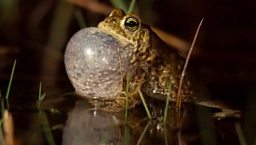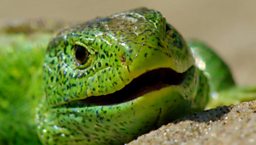3 Things to See in Episode 1
Natterjack toads (Epidalea calamita)

Commonly known as the ‘running’ toad, they spend their winters and the peaks of summer underground, sleeping in sandy burrows to escape the extreme weather. Combined with the fact that they require a highly specialised environment to survive, spotting them in the wild can be almost impossible. Living in shallow sandy dunes where the grass grows to just the right height, Natterjacks are finding the North Wales coast near the Dee Estuary to be a sanctuary that supports the slightly above-average temperatures they require, and in this episode we see the toads wake up from their seasonal slumber and begin the quest to find a mate, by whatever means necessary. With less than 300 of these toads in Wales you’re far more likely to hear one than see one, as their mating calls can be heard from over a mile away.
Sand Lizard (Lacerta agilis)

In the scorching sand dunes of Ynys Las, just north of Aberystwyth, lives Wales’s very own wild dragon. Male sand lizards are a vivid green colour and can reach up to 20cm, whilst the females are less dramatic in colour and spend more of their time hiding underground. Sand lizards require a mix of mature grass and vegetation as well as open, sunny, sandy areas to lay their eggs. Sand lizards were extinct in Wales until the early 2000s when they were re-introduced to the area by conservation charities. Now, it seems they are here to stay, as the coastal climate of sunny West Wales provides the perfect environment for them to call Wales home once again! The population of sand lizards in West Wales is ever increasing, thanks to the hard work of the conservationists and experts involved in their re-introduction. Their West Wales abode is not without its dangers however… as you’ll see in episode 1.
Black Grouse (Tetrao tetrix)

Internationally renowned for their lekking behaviour that sees them gather in groups and strut their stuff to find a mate; their breeding display is more akin to a wild-west shootout than a North Wales hillside. These flamboyant birds battle and brawl their way through the spring months in the hope of finding a female to breed with. There are only a few hundred of these birds in Wales, and they fly into the leks from the surrounding areas. Episode 1 sees some fowl play on the hillside - the dominant male faces a challenger for access to the prize females.
